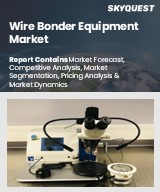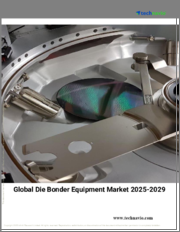
|
시장보고서
상품코드
1698459
반도체 접합 재료 시장 : 예측(2025-2030년)Semiconductor Bonding Material Market - Forecasts from 2025 to 2030 |
||||||
반도체 접합 재료 시장은 2025-2030년의 예측 기간에 CAGR 5.25%로 성장할 것으로 예측됩니다.
반도체는 컴퓨터나 전자기기의 제조에 도움이 되는 본질적인 전기적 특성을 가진 물질입니다. 또한 특정 상황에서 전기를 통하는 화학적으로 고체 상태의 물질이기도 합니다. 방위 장비, 통신 시스템, 운송, 컴퓨팅, 의료, 재생 에너지는 유리한 반도체 용도 중 일부입니다. 원자는 반도체 배열로 결합되어 수많은 집적회로와 제조 툴을 만들어 냅니다. 반도체 접합 모델은 균일하고 일정한 반도체 재료 구조를 가지고 있습니다.
시장 동향 :
- 마이크로 일렉트로닉스 수요 증가로 시장 성장 촉진: 반도체 접합 재료 시장은 전기자동차 및 MEMS 시스템에 대한 관심 증가에 힘입어 빠르게 성장하고 있습니다. 적층 다이 시스템을 이용한 커넥티드 디바이스의 보급은 세계 반도체 접합 산업을 확대할 것이며, 5G 네트워크 구축과 6G 기술에 대한 지속적인 연구는 이 시장의 세계 성장을 가속화하고 있습니다. 스마트폰과 웨어러블 기기의 보급은 세계 시장 동향을 더욱 가속화하고 있습니다. 또한 커넥티드 물류, 스마트 아키텍처, 홈자동화, 지능형 교통시스템 등의 분야에서 반도체의 광범위한 용도에 힘입어 향후 수년간 지속적인 성장이 예상됩니다.
- 세계 반도체 접합 재료 시장 분석 : 반도체 접합 재료 시장은 미주, 유럽, 유럽, 중동 및 아프리카, 아시아태평양의 5개 주요 지역으로 분류됩니다. 아시아태평양은 주요 현지 공급업체들의 전략적 투자와 이 분야에서 중요한 역할을 하고 있는 기존 반도체 산업을 바탕으로 예측 기간 중 시장 점유율을 독식할 것으로 예상됩니다. 세계 최대 반도체 기업의 본거지인 이 지역에서는 중국, 인도, 베트남 등의 국가에서 산업 인프라 강화를 위한 투자가 확대되고 있습니다. 또한 국내 주요 벤더 및 정부 기관들은 하이브리드 접합과 같은 첨단 기술에 많은 자원을 투입하고 있으며, 이는 예측 기간 중 시장 성장의 원동력이 될 것으로 예상됩니다.
이 보고서에서 다루고 있는 주요 기업에는 Kulicke & Soffa, Shibaura Mechatronics, Yamaha Motor Robotics Corporation Co., Fuji Corporation, Panasonic Corporation, SUSS MicroTech SE 등이 있습니다.
이 보고서의 주요 장점
- 인사이트 분석 : 고객 부문, 정부 정책 및 사회경제적 요인, 소비자 선호도, 산업별, 기타 하위 부문에 초점을 맞추고 주요 지역뿐만 아니라 신흥 지역까지 포괄하는 상세한 시장 인사이트를 얻을 수 있습니다.
- 경쟁 구도: 세계 주요 기업이 채택하고 있는 전략적 전략을 이해하고, 적절한 전략을 통한 시장 침투 가능성을 파악할 수 있습니다.
- 시장 성장 촉진요인과 미래 동향 : 역동적인 요인과 매우 중요한 시장 동향, 그리고 이들이 향후 시장 발전을 어떻게 형성할 것인지에 대해 알아봅니다.
- 실행 가능한 제안: 역동적인 환경 속에서 새로운 비즈니스 스트림과 매출을 발굴하기 위한 전략적 의사결정에 인사이트를 활용합니다.
- 다양한 사용자에 대응: 스타트업, 연구기관, 컨설턴트, 중소기업, 대기업에 유익하고 비용 효율적입니다.
어떤 용도로 사용되는가?
산업 및 시장 인사이트, 사업 기회 평가, 제품 수요 예측, 시장 진출 전략, 지역적 확장, 설비 투자 결정, 규제 프레임워크와 영향, 신제품 개발, 경쟁의 영향
분석 범위
- 과거 데이터(2022-2024년) 및 예측 데이터(2025-2030년)
- 성장 기회, 과제, 공급망 전망, 규제 프레임워크, 고객 행동, 동향 분석
- 경쟁사 포지셔닝, 전략 및 시장 점유율 분석
- 매출 성장률 및 예측 분석 : 부문별/지역별(국가별)
- 기업 프로파일링(전략, 제품, 재무정보, 주요 동향 등)
반도체 접합 재료 시장은 다음과 같은 부문별로 분석됩니다. :
유형별
- 다이 본더
- 웨이퍼 본더
- 플립칩 본더
접합 유형별
- 다이 간 접합
- 웨이퍼 간 접합
- 다이-웨이퍼 접합
용도별
- RF 디바이스
- 3D NAND
- CMOS 이미지 센서
- LED
- MEMS 센서
지역별
- 미국
- 미국
- 유럽, 중동 및 아프리카
- 독일
- 네덜란드
- 기타
- 아시아태평양
- 중국
- 일본
- 대만
- 한국
- 기타
목차
제1장 서론
- 시장 개요
- 시장의 정의
- 분석 범위
- 시장 세분화
- 통화
- 전제조건
- 기준연도와 예측연도 타임라인
- 이해관계자에 대한 주요 이점
제2장 분석 방법
- 분석 디자인
- 분석 프로세스
제3장 개요
- 주요 분석 결과
- 애널리스트 뷰
제4장 시장 역학
- 시장 성장 촉진요인
- 시장 성장 억제요인
- Porter's Five Forces 분석
- 업계 밸류체인 분석
제5장 반도체 접합 재료 시장 : 유형별
- 서론
- 다이 본더
- 웨이퍼 본더
- 플립 칩 본더
제6장 반도체 접합 재료 시장 : 접합의 유형별
- 서론
- 다이 간 접합
- 웨이퍼 간 접합
- 다이·웨이퍼 접합
제7장 반도체 접합 재료 시장 : 용도별
- 서론
- RF 디바이스
- 3D NAND
- CMOS 이미지 센서
- LED
- MEMS·센서
제8장 반도체 접합 재료 시장 : 지역별
- 세계 개요
- 아메리카
- 미국
- 유럽, 중동 및 아프리카
- 독일
- 네덜란드
- 기타
- 아시아태평양
- 중국
- 일본
- 대만
- 한국
- 기타
제9장 경쟁 환경과 분석
- 주요 기업과 전략 분석
- 시장 점유율 분석
- 기업인수합병(M&A), 합의, 사업 협력
- 경쟁 대시보드
제10장 기업 개요
- Kulicke & Soffa
- Shibaura Mechatronics
- Yamaha Motor Robotics Corporation Co.
- Fuji Corporation
- Panasonic Corporation
- SUSS MicroTech SE
- ASM Pacific Technology Ltd.
- Fasford Technology
- DuPont
The semiconductor bonding material market is projected to increase at a CAGR of 5.25% over the forecast period between 2025 and 2030.
The semiconductor is a material with essential electric properties that make it useful for manufacturing computers and electronic equipment. Additionally, it is a chemically solid substance that, under certain circumstances, conducts electricity. Defense equipment, communication systems, transportation, computing, healthcare, and renewable energy are a few of the lucrative semiconductor applications. Atoms are bonded together in semiconductor arrangements to create a huge number of integrated circuits and production tools. The semiconductor bonding model's uniform and constant semiconductor material structure.
Market Trends:
- Growing Demand for Microelectronics Fuels Market Growth: The semiconductor bonding material market is expanding rapidly, driven by increasing interest in electric vehicles and micro-electromechanical systems. The proliferation of connected devices utilizing stacked die systems is set to enlarge the global semiconductor bonding industry. The rollout of 5G networks, coupled with ongoing research into 6G technology, is accelerating this market's worldwide growth. Rising adoption of smartphones and wearable devices is further amplifying global market trends. Additionally, the market is expected to see continued growth in the coming years, supported by the wide-ranging applications of semiconductors in areas such as connected logistics, smart architecture, home automation, and intelligent transportation systems.
- Global Segmentation of the Semiconductor Bonding Material Market: The semiconductor bonding material market is categorized into five key regions: the Americas, Europe, the Middle East and Africa, and Asia-Pacific. The Asia-Pacific region is projected to dominate the market share during the forecast period, bolstered by strategic investments from major local suppliers and its well-established semiconductor industry, a significant force in the sector. Home to some of the world's largest semiconductor firms, the region is seeing growing investments to strengthen industry infrastructure in countries like China, India, and Vietnam. Furthermore, leading domestic vendors and government bodies are channeling substantial resources into advanced technologies, such as hybrid bonding, which is expected to drive market growth throughout the forecast period.
Some of the major players covered in this report include Kulicke & Soffa, Shibaura Mechatronics, Yamaha Motor Robotics Corporation Co., Fuji Corporation, Panasonic Corporation, SUSS MicroTech SE, among others.
Key Benefits of this Report:
- Insightful Analysis: Gain detailed market insights covering major as well as emerging geographical regions, focusing on customer segments, government policies and socio-economic factors, consumer preferences, industry verticals, and other sub-segments.
- Competitive Landscape: Understand the strategic maneuvers employed by key players globally to understand possible market penetration with the correct strategy.
- Market Drivers & Future Trends: Explore the dynamic factors and pivotal market trends and how they will shape future market developments.
- Actionable Recommendations: Utilize the insights to exercise strategic decisions to uncover new business streams and revenues in a dynamic environment.
- Caters to a Wide Audience: Beneficial and cost-effective for startups, research institutions, consultants, SMEs, and large enterprises.
What do businesses use our reports for?
Industry and Market Insights, Opportunity Assessment, Product Demand Forecasting, Market Entry Strategy, Geographical Expansion, Capital Investment Decisions, Regulatory Framework & Implications, New Product Development, Competitive Intelligence
Report Coverage:
- Historical data from 2022 to 2024 & forecast data from 2025 to 2030
- Growth Opportunities, Challenges, Supply Chain Outlook, Regulatory Framework, and Trend Analysis
- Competitive Positioning, Strategies, and Market Share Analysis
- Revenue Growth and Forecast Assessment of segments and regions including countries
- Company Profiling (Strategies, Products, Financial Information, and Key Developments among others)
The Semiconductor Bonding Material Market is analyzed into the following segments:
By Type
- Die Bonder
- Wafer Bonder
- Flip Chip Bonder
By Bonding Type
- Die-to-Die Bonding,
- Wafer-to-Wafer Bonding
- Die-to-Wafer Bonding
By Application
- RF Devices
- 3D NAND
- CMOS Image Sensors
- LED
- MEMS & Sensors
By Geography
- Americas
- US
- Europe, the Middle East, and Africa
- Germany
- Netherlands
- Others
- Asia Pacific
- China
- Japan
- Taiwan
- South Korea
- Others
TABLE OF CONTENTS
1. INTRODUCTION
- 1.1. Market Overview
- 1.2. Market Definition
- 1.3. Scope of the Study
1.4. Market Segmentation
- 1.5. Currency
- 1.6. Assumptions
- 1.7. Base and Forecast Years Timeline
- 1.8. Key benefits for the stakeholders
2. RESEARCH METHODOLOGY
- 2.1. Research Design
- 2.2. Research Process
3. EXECUTIVE SUMMARY
- 3.1. Key Findings
- 3.2. Analyst View
4. MARKET DYNAMICS
- 4.1. Market Drivers
- 4.2. Market Restraints
- 4.3. Porter's Five Forces Analysis
- 4.3.1. Bargaining Power of Suppliers
- 4.3.2. Bargaining Power of Buyers
- 4.3.3. The Threat of New Entrants
- 4.3.4. Threat of Substitutes
- 4.3.5. Competitive Rivalry in the Industry
- 4.4. Industry Value Chain Analysis
5. SEMICONDUCTOR BONDING MATERIAL MARKET BY TYPE
- 5.1. Introduction
- 5.2. Die Bonder
- 5.3. Wafer Bonder
- 5.4. Flip Chip Bonder
6. SEMICONDUCTOR BONDING MATERIAL MARKET BY BONDING TYPE
- 6.1. Introduction
- 6.2. Die-to-Die Bonding,
- 6.3. Wafer-to-Wafer Bonding
- 6.4. Die-to-Wafer Bonding
7. SEMICONDUCTOR BONDING MATERIAL MARKET BY APPLICATION
- 7.1. Introduction
- 7.2. RF Devices
- 7.3. 3D NAND
- 7.4. CMOS Image Sensors
- 7.5. LED
- 7.6. MEMS & Sensors
8. SEMICONDUCTOR BONDING MATERIAL MARKET BY GEOGRAPHY
- 8.1. Global Overview
- 8.2. Americas
- 8.2.1. US
- 8.3. Europe, Middle East, and Africa
- 8.3.1. Germany
- 8.3.2. Netherlands
- 8.3.3. Others
- 8.4. Asia-Pacific
- 8.4.1. China
- 8.4.2. Japan
- 8.4.3. Taiwan
- 8.4.4. South Korea
- 8.4.5. Others
9. COMPETITIVE ENVIRONMENT AND ANALYSIS
- 9.1. Major Players and Strategy Analysis
- 9.2. Market Share Analysis
- 9.3. Mergers, Acquisitions, Agreements, and Collaborations
- 9.4. Competitive Dashboard
10. COMPANY PROFILES
- 10.1. Kulicke & Soffa
- 10.2. Shibaura Mechatronics
- 10.3. Yamaha Motor Robotics Corporation Co.
- 10.4. Fuji Corporation
- 10.5. Panasonic Corporation
- 10.6. SUSS MicroTech SE
- 10.7. ASM Pacific Technology Ltd.
- 10.8. Fasford Technology
- 10.9. DuPont



















